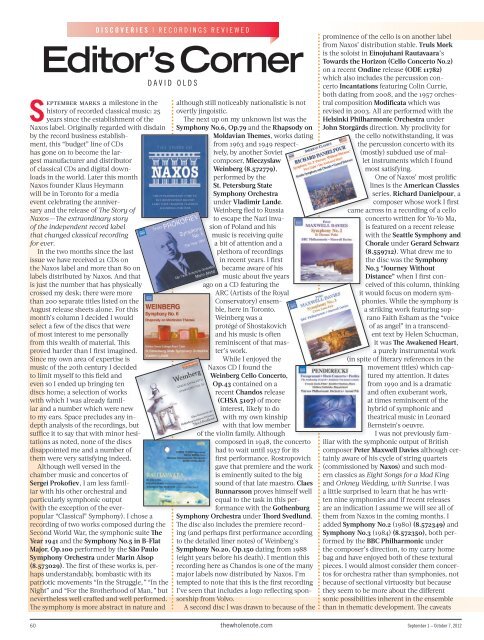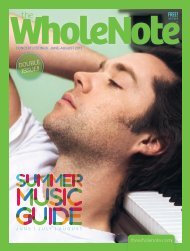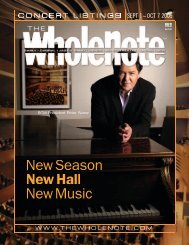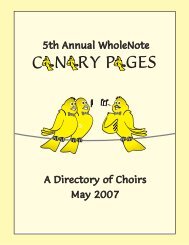PDF Version
PDF Version
PDF Version
- No tags were found...
You also want an ePaper? Increase the reach of your titles
YUMPU automatically turns print PDFs into web optimized ePapers that Google loves.
DISCOVERIES | RECORDINGS REVIEWEDEditor’s CornerDAVID OLDSSeptember marks a milestone in thehistory of recorded classical music: 25years since the establishment of theNaxos label. Originally regarded with disdainby the record business establishment,this “budget” line of CDshas gone on to become the largestmanufacturer and distributorof classical CDs and digital downloadsin the world. Later this monthNaxos founder Klaus Heymannwill be in Toronto for a mediaevent celebrating the anniversaryand the release of The Story ofNaxos — The extraordinary storyof the independent record labelthat changed classical recordingfor ever.In the two months since the lastissue we have received 21 CDs onthe Naxos label and more than 80 onlabels distributed by Naxos. And thatis just the number that has physicallycrossed my desk; there were morethan 200 separate titles listed on theAugust release sheets alone. For thismonth’s column I decided I wouldselect a few of the discs that wereof most interest to me personallyfrom this wealth of material. Thisproved harder than I first imagined.Since my own area of expertise ismusic of the 20th century I decidedto limit myself to this field andeven so I ended up bringing tendiscs home; a selection of workswith which I was already familiarand a number which were newto my ears. Space precludes any indepthanalysis of the recordings, butsuffice it to say that with minor hesitationsas noted, none of the discsdisappointed me and a number ofthem were very satisfying indeed.Although well versed in thechamber music and concertos ofSergei Prokofiev, I am less familiarwith his other orchestral andparticularly symphonic output(with the exception of the everpopular“Classical” Symphony). I chose arecording of two works composed during theSecond World War, the symphonic suite TheYear 1941 and the Symphony No.5 in B-FlatMajor, Op.100 performed by the São PauloSymphony Orchestra under Marin Alsop(8.573029). The first of these works is, perhapsunderstandably, bombastic with itspatriotic movements “In the Struggle,” “In theNight” and “For the Brotherhood of Man,” butnevertheless well crafted and well performed.The symphony is more abstract in nature andalthough still noticeably nationalistic is notovertly jingoistic.The next up on my unknown list was theSymphony No.6, Op.79 and the Rhapsody onMoldavian Themes, works datingfrom 1963 and 1949 respectively,by another Sovietcomposer, MieczyslawWeinberg (8.572779),performed by theSt. Petersburg StateSymphony Orchestraunder Vladimir Lande.Weinberg fled to Russiato escape the Nazi invasionof Poland and hismusic is receiving quitea bit of attention and aplethora of recordingsin recent years. I firstbecame aware of hismusic about five yearsago on a CD featuring theARC (Artists of the RoyalConservatory) ensemble,here in Toronto.Weinberg was aprotégé of Shostakovichand his music is oftenreminiscent of that master’swork.While I enjoyed theNaxos CD I found theWeinberg Cello Concerto,Op.43 contained on arecent Chandos release(CHSA 5107) of moreinterest, likely to dowith my own kinshipwith that low memberof the violin family. Althoughcomposed in 1948, the concertohad to wait until 1957 for itsfirst performance. Rostropovichgave that premiere and the workis eminently suited to the bigsound of that late maestro. ClaesBunnarsson proves himself wellequal to the task in this performancewith the GothenburgSymphony Orchestra under Thord Svedlund.The disc also includes the premiere recording(and perhaps first performance accordingto the detailed liner notes) of Weinberg’sSymphony No.20, Op.150 dating from 1988(eight years before his death). I mention thisrecording here as Chandos is one of the manymajor labels now distributed by Naxos. I’mtempted to note that this is the first recordingI’ve seen that includes a logo reflecting sponsorshipfrom Volvo.A second disc I was drawn to because of theprominence of the cello is on another labelfrom Naxos’ distribution stable. Truls Mørkis the soloist in Einojuhani Rautavaara’sTowards the Horizon (Cello Concerto No.2)on a recent Ondine release (ODE 11782)which also includes the percussion concertoIncantations featuring Colin Currie,both dating from 2008, and the 1957 orchestralcomposition Modificata which wasrevised in 2003. All are performed with theHelsinki Philharmonic Orchestra underJohn Storgärds direction. My proclivity forthe cello notwithstanding, it wasthe percussion concerto with its(mostly) subdued use of malletinstruments which I foundmost satisfying.One of Naxos’ most prolificlines is the American Classicsseries. Richard Danielpour, acomposer whose work I firstcame across in a recording of a celloconcerto written for Yo-Yo Ma,is featured on a recent releasewith the Seattle Symphony andChorale under Gerard Schwarz(8.559712). What drew me tothe disc was the SymphonyNo.3 “Journey WithoutDistance” when I first conceivedof this column, thinkingit would focus on modern symphonies.While the symphony isa striking work featuring sopranoFaith Esham as the “voiceof as angel” in a transcendenttext by Helen Schucman,it was The Awakened Heart,a purely instrumental work(in spite of literary references in themovement titles) which capturedmy attention. It datesfrom 1990 and is a dramaticand often exuberant work,at times reminiscent of thehybrid of symphonic andtheatrical music in LeonardBernstein’s oeuvre.I was not previously familiarwith the symphonic output of Britishcomposer Peter Maxwell Davies although certainlyaware of his cycle of string quartets(commissioned by Naxos) and such modernclassics as Eight Songs for a Mad Kingand Orkney Wedding, with Sunrise. I wasa little surprised to learn that he has writtennine symphonies and if recent releasesare an indication I assume we will see all ofthem from Naxos in the coming months. Iadded Symphony No.2 (1980) (8.572349) andSymphony No.3 (1984) (8.572350), both performedby the BBC Philharmonic underthe composer’s direction, to my carry homebag and have enjoyed both of these texturalpieces. I would almost consider them concertosfor orchestra rather than symphonies, notbecause of sectional virtuosity but becausethey seem to be more about the differentsonic possibilities inherent in the ensemblethan in thematic development. The caveats60 thewholenote.com September 1 – October 7, 2012
















